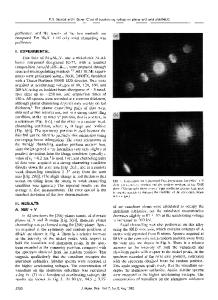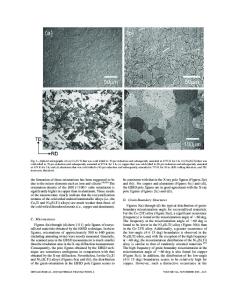Antiphase Boundary Tubes in Ordered Intermetallic Compounds
- PDF / 3,630,926 Bytes
- 6 Pages / 420.48 x 639 pts Page_size
- 24 Downloads / 525 Views
ANTIPHASE BOUNDARY TUBES IN ORDERED INTERMETALLIC COMPOUNDS ALFONSO H.W. NGAN*, I.P. JONES AND R.E. SMALLMAN School of Metallurgy and Materials, University of Birmingham, Birmingham B15 2TT, England. * Now at Department of Materials, University of Oxford, Oxford OXI 3PH, England. ABSTRACT TEM observations suggest the presence of edge-type strain fields around antiphase boundary tubes in deformed L1 2 compounds such as Ni3 AI and Fe 3Ge. The present paper aims at discussing the origin of these strain fields. Some preliminary results concerning the thermal instability of the tubes will also be discussed. INTRODUCTION Antiphase boundary (APB) tubes are a type of defect specific to ordered structures. Geometrically speaking, APB tubes are polygonal cylinders whose faces are bounded by APB's. They were first proposed by Vidoz and Brown [1] to account for the generally high work-hardening rates in well-ordered intermetallic compounds. In their formation mechanism, an APB tube may result from the glide of an APB-dissociated superdislocation which has been jogged previously by a forest dislocation. Other formation mechanisms which involve the cross-slip of screw superdislocations were proposed subsequently ([2] & [4]). Experimentally, the first evidence of APB tubes was found in highly deformed Fe-35.5%A! by Crawford [3] using TEM methods. Chou and Hirsch [4] later formulated a contrast formation mechanism which considered only the step-wise and rigid nature of the crystal displacement across each of the APB's forming the tube. Because no atomic relaxation of the APB's was taken into account and also, the joining of APB's at the corners of the tubes does not require dislocations, no continuous strain field was then thought to be associated with the tubes. In Chou and Hirsch's mechanism, APB tubes can therefore be imageable via superlattice reflections only; when imaged under fundamental reflections, they should always be out of contrast since g'RF, where g is the diffraction vector and RF the APB displacement, is an integer. As Sun [5] has shown, however, APB tubes do in fact exhibit detectable contrast when imaged under certain fundamental reflections. Sun ascribed this supplementary contrast in fundamental reflections to the strain field caused by the surface tension effect of the APB's forming the tube. However, the contrast which he predicted was two orders of magnitude lower than that observed experimentally. The present paper therefore suggests a different interpretation of the strain fields of APB tubes with the aim of explaining quantitatively the tube contrast. The present paper also reports some preliminary results concerning the thermal instability of APB tubes. Potential effects of the observed thermal instability upon work-hardening behaviour will be mentioned briefly. EXPERIMENTAL The observations described in the present paper were made on two L1 2 compounds: Ni 3AI and Fe 3Ge. The specimen preparation procedures and details regarding compression tests and TEM observations can be found in references [6] and
Data Loading...











